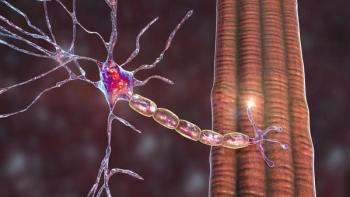
Exploring New Pathways in Muscular Dystrophy Research: From Fibrosis to Function
Matthew Alexander, PhD, a neuromuscular expert, discussed the evolving landscape of targeted therapies in muscular dystrophies, from fibrosis and glycosylation to combination strategies with gene therapy.
This article originally appeared on our sister site,
A series of FDA approvals and clinical advances reflecting a shift toward disease-modifying and potentially gene-correcting therapies have significantly expanded the treatment landscape for Duchenne muscular dystrophy (DMD) in recent years. The field's clinical practice gained its first gene therapy with the accelerated approval of delandistrogene moxeparvovec (Elevidys; Sarepta Therapeutics) for ambulatory patients with DMD in 2023. Exon-skipping therapies–such as eteplirsen, golodirsen, viltolarsen, and casimersen–have secured approval in parallel for subsets of patients with specific DMD gene mutations, thus providing patients with more personalized options.
The field is still trying to find new ways to treat muscular dystrophies despite the influx of newly approved therapeutics, however. Different, innovative signaling pathways are being looked at for this purpose. At
Alexander, an associate professor of pediatric neurology and genetics at the University of Alabama Birmingham, sat down with CGTLive®'s sister site NeurologyLive® during the meeting to converse about these presentations and why the topic is of interest. In the discussion, he gave clinical insight on the latest signaling pathways being explored in muscular dystrophy research, touching on targets like fibrosis and stabilizing myofiber membranes to address glycosylation disorders. In addition, he discussed the complexity of personalized treatment, the promise of genetic modifiers, and how a combination of treatments may pave the way for more effective, system-wide disease control across the muscular dystrophy spectrum.
NeurologyLive: What are the key signaling pathways currently being targeted in the treatment of muscular dystrophies, and what role do they play in disease progression?
Matthew Alexander, PhD: I’ll try to give a 30,000-foot overview. There's a big interest right now in blocking fibrosis as a general mechanism. In many muscular dystrophies—like the limb-girdle muscular dystrophies, Duchenne (which my lab focuses on)—fibrosis occurs predominantly in skeletal muscle, but also in the heart and lungs.
Several companies are now targeting fibrosis with small molecules, neutralizing antibodies, and other inhibitors. These have shown a lot of benefit in animal models and are now advancing into clinical trials, which is exciting.
There are also approaches focused on stabilizing the myofiber membrane. Some of these use polymer-based compounds that physically protect or reinforce the dystrophin-associated complex. The thinking is that if you make the muscle more stable, it’s less prone to calcium leakage, immune signaling, and the cytokine storms that continue to drive disease progression in muscle tissue.
What are some of the major challenges clinicians face when targeting these signaling pathways in muscular dystrophies, and how are we working to overcome them?
That’s a complex question. First, not all muscular dystrophies are the same—even within the same gene mutation, there can be a wide spectrum of symptoms. In Duchenne, for example, it depends heavily on where the mutation is located. Some patients present milder forms and can walk past age 13, while others experience more severe progression.
We’re also discovering secondary mutations or modifier genes. There's strong interest, both in academia and drug development, in identifying genetic modifiers that may serve as future drug targets to slow disease progression. Precision medicine is a big piece of the puzzle. Not every patient will respond the same to treatment, so we need comprehensive clinical workups—looking beyond skeletal muscle to liver and cardiac function as well. Whether you're using a small molecule or gene therapy, these individual factors are key to guiding treatment.
How do therapies targeting these pathways differ in their approach for different types of muscular dystrophy, such as Duchenne, Becker, or LGMDs?
We’ve come a long way since dystrophin was first identified nearly 30 years ago. Once we found dystrophin, we began to identify its interacting proteins. Mutations in many of these proteins can also cause muscular dystrophy, often with varying symptoms.
Some patients remain ambulatory, while others present with congenital muscular dystrophy and severe hypotonia from birth. For example, mutations in the sarcoglycan complex—one of dystrophin’s key interaction networks—can cause serious issues in skeletal muscle, the heart, and even the brain.
One area my lab and others are exploring is glycosylation disorders. These involve enzymes that modify proteins, helping them reach the myofiber membrane. When this modification is impaired, the proteins can get trapped inside the cell. Some groups are trying to bypass this issue using gene therapy or by relieving ER/Golgi stress.
Do you see potential in combining pathway-targeted therapies with other approaches, such as gene or protein replacement therapies, to enhance outcomes?
Absolutely. I see combinatorial therapies as the future. Many gene therapies primarily target skeletal muscle or the heart but miss other affected organs like the brain or lungs.
You can imagine a scenario in Duchenne, for example, where Elevidys (microdystrophin gene therapy) stabilizes the myofiber membrane, while a second agent blocks fibrosis or targets calcium dysregulation. There’s a lot of damaging ion release that occurs, and reducing that could make a big difference. Combining agents to block fibrosis, strengthen muscle, or reduce immune signaling could offer much more holistic disease control than a single therapy alone.
Has there been any discussion in the clinical community about which combination approaches might work best?
Yes, we’re already seeing this in spinal muscular atrophy (SMA), where therapies like Zolgensma or Spinraza are being combined with myostatin inhibitors. There were a few sessions at the conference on this topic.
The idea is to restore motor neuron function with one therapy while simultaneously building up skeletal muscle by blocking myostatin. This has shown promise in animal models and early trials. We're just waiting for results from later-stage studies, but so far, it looks very promising.
This transcript has been edited for clarity.
Newsletter
Stay at the forefront of cutting-edge science with CGT—your direct line to expert insights, breakthrough data, and real-time coverage of the latest advancements in cell and gene therapy.











































